 |
  Home | Contact | Site Map |

| Top Destinations |
|
You are here Home » Top Destinations » Jammu & Kashmir
Honeymoon in Jammu and Kashmir India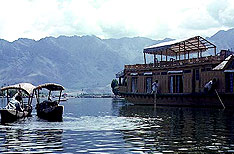 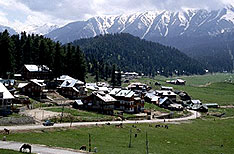 About jammu and Kashmir Jammu and Kashmir is the sixth largest state in India including the area occupied by Pakistan and China. The crown of India lies in the extreme north of the country and is bounded on three sides by China, Afghanistan and Pakistan. The entire state is almost mountainous, broken by stretches of valley and dotted with mountain lakes. The state is studded with a number of hill stations, which are refreshing cool in summer. They offer to the tourists a leisurely or adventurous holiday amidst breath-taking scenery. Strategically located Jammu and Kashmir State constitutes the northern most extremity of India. Large parts of it have, however, been annexed by China and Pakistan. Yet, some of the most majestic parts of this state remain in India. The State is bounded by Pakistan, Afghanistan and China from the West to the East. A major portion of Jammu & Kashmir State consists of the western Himalayas, which besides many lofty mountain ranges with varying heights of 3000 to 6000 meters and above, also abound in rivers, lakes, passes, glaciers, plateaus and plains. The number of streams, brooks, hill torrents and rivers is also fairly large. The most important rivers are the Indus, Chenab, Jehlum and Ravi. HISTORYThe state of Jammu and Kashmir which had earlier been under Hindu rulers and Muslim Sultans, became part of the Mughal Empire under Akbar. After a period of Afghan rule from 1756, it was annexed to the to the Sikh kingdom of the Punjab in 1819. In 1846 the Sikh ruler Maharaja Ranjit Singh entrusted the principality of Jammu and adjacent areas to Gulab Singh, his Dogra General. Gulab Singh brought large areas including Ladakh, Zanskar, Gilgit and Baltistan under his control. Jammu and Kashmir came into being as a single political and geographical entity following the Treaty of Amristar between the British Government and Gulab singh signed on March 16, 1846. The Treaty handed over the control of the Kashmir State to the Dogra ruler of Jammu who had earlier annexed Ladakh. Thus a new State comprising three distinct religions of Jammu, Kashmir and Ladakh was formed with Maharaja Gulab Singh as its founder ruler. Jammu & Kashmir in the year 1947 was an independent country for all practical purposes. The Maharaja who ruled the State had signed agreements with both Pakistan and India to remain neutral and not be part of either country. India honoured that agreement but Pakistan did not. Pakistani raiders and soldiers attacked the state in 1947 forcing the Maharaja to flee to India. The Maharaja asked India to help his people who were being killed and looted by the Pakistani raiders. He also agreed to make Jammu &; Kashmir part of India. The Indian ruler at that time was Prime Minister Jawaharlal Nehru. He accepted Jammu &; Kashmir's accession to India and agreed to rescue his people from the Pakistani attackers. Indian troops were flown into the Kashmir Valley and they managed to drive away most of the Pakistani raiders from the state. But a large area of the state remained under the control of Pakistani soldiers. These areas were difficult to reach because they were surrounded by tall mountain ranges. Heavy fighting took place in 1947-48 between the Indian and Pakistani forces over Kashmir. On January 1, 1948 India took up the issue of Pak aggression in Jammu and Kashmir in UNO under Article 35 of its charter. After long debates, cease-fire came into operation on the midnight of January 1, 1949 which created the first Line-of-Control. While the people of the state continue to march ahead for socio-economic emancipation as per the Naya Kashmir charter for better quality of life, Pakistan continued with her plans to grab Kashmir through force. Pakistan waged two wars in 1965 and 1971 to annex Kashmir but the people gave her befitting reply and repulsed her attacks with the help of army like they did in 1947-48. Failing to match India?s military power, it launched a low intensity war through militancy in 1990 which took a toll of 20,000 human lives besides destroying private and public property. The high point of the movement was July 13, 1931 when 22 protesters were martyred. The event strengthened the movement and contrary to the expectations of the then rulers, the peopled emerged more determined in their resolution to seek an end to autocratic rule. By the time the rulers could realise the futility of breaking the will of the people with the might of the State, the National Conference, headed by Sheikh Mohammad Abdullah, had become a mass movement and a force to reckon with. It broke the barriers of region and religion and became a popular and secular voice of the people of the State whose collective yearning was freedom from autocracy and the establishment of a popular rule. The feudal dispensation in the State, however, was too harsh for the people to live under and towards the end of a hundred years of this rule when their Indian brethren were fighting for independence from the British under the inspiring leadership of Mahatma Gandhi and Pandit Jawahar Lal Nehru, the Kashmiris led by a towering personality, the Sher-I-Kashmir Sheikh Mohammad Abdullah, rose against the autocracy. The autocratic rule came down heavily on the people?s freedom movement. However, the people laid their lives in the cause of freedom and to uphold the ideals of secularism, equality, democracy and brotherhood. CULTUREThe state has a very rich history and a distinct culture where people of all faiths live in perfect harmony. Jammu and Kashmir has three distinct components - Hindu majority Jammu, Buddhist dominated Ladakh in the North and predominantly Muslim populated Valley, besides what is under Pakistan occupation. The state also have a unique feature of having some of the most sacred Temples, Mosques, Monasteries, and Caves. A visit to this paradise, resplendent in nature's glory, will linger long in the memory of the visitor. The state of Jammu & Kashmir is a region of widely varying people and geography. In the south, Jammu is a transition zone from the Indian plains to the Himalaya. Nature has lavishly endowed Kashmir with certain distinctive favours which hardly find a parallel in any alpine land of the world. Correctly, the rest of the state is Kashmir but in practice this title is reserved for the beautiful valley of Kashmir, a large Himalayan valley in the north of the state. A spell on a houseboat on Dal Lake has always been one of India's real treats and Kashmir also offers some delightful trekking opportunities and unsurpassed scenery. Set in the womb of the Himalayas and gifted with beautiful and inspiring natural scenery, it emerged as a highly advanced seat of learning from very early times, taking its place along with the famous Universities of Taxila and Nalanda. It has also been embracing point of advent of Islam bringing in its fold finest traditions of Persian civilization, tolerance, brotherhood and sacrifice. Ramparts of high mountains and seclusion of the land helped her top reserve the life and conditions of early times which is rather difficult to resuscitate in regard to other such mountainous regions. The cultural heritage of Kashmir is, therefore, very rich and derives its inspiration and strength both from her natural environs and the rich literature and literary traditions alike. Jammu on the other hand has been the seat of Rajas and Maharajas which have cemented and enriched the cultural, historical and social bonds of all these diverse ethnic and linguistic divisions of the state. The ancient archeological monuments and remnants speak volume of the district cultural traditions of the state. Jammu the land of the Dogras, offer an entirely different fare of dances and music. Over the centuries long spell of separation from their soldier, husbands and brothers have led the hardy but graceful women of the Duggar to evolve many diverting dances and songs to keep themselves in cheer in their free moments. The songs of separation, the ever increasing yearning for reunion with the beloved, the hard life on the mountain slopes and various other themes connected with their day-to-day life find their echo in folk songs and dances. FESTIVALSJammu celebrates Lohri and Baisakhi in February. Every year a 3-day Jammu Crafts Mela is also organised during Baisakhi at the picturesque Mansar Lake, 60-km from Jammu. Bahu Mela, a major festival of Jammu region is held at the Kali temple in Bahu Fort, twice a year during March-April and September-October. In Srinagar, besides Id other important muslim festivals are Urs at Khaneka in downtown Srinagar and Urs at Chrar-e-Sharif. The annual Ladakh festival is held in September; the Hemis Festival features dance performed by the monks dressed in colourful robes wearing different forms of masks. FLORA & FAUNAThe State is rich in flora and fauna. Kashmir abounds in rich flora. The most magnificent of the Kashmir trees is the Chinar found throughout the valley. Mountain ranges in the Valley have dense deodar, pine and fir. Walnut, willow, almond and cider also add to the rich flora of Kashmir. The dense forests of Kashmir are a delight to the sport-lovers and adventures for whom there are Ibex, Snow Leopard, Musk deer, wolf, Markhor, Red bear, Black bear and Leopard. The winged game include ducks, goose, partridge, chakor, pheasant, wagtails, herons, water pigeons, warblers, and doves. In the hilly regions of Doda, Udhampur, Poonch and Rajouri there is a large and varied fauna including leopard, cheetah and deer, wild sheep, bear, brown musk shrew, musk rat. Varieties of snakes, bats, lizards and frogs are also found in the region. The game birds in Jammu include chakor, snow partridge, pheasants, peacock. In Jammu, the flora ranges from the thorn bush type of the arid plain to the temperate and alpine flora of the higher altitudes. Of the broad leaf trees there are maple, horse chest nuts, silver fir etc. At the higher altitudes there are birch, rhododendron, Berbers and a large number of herbal plants. In otherwise arid desert of Ladakh some 240 species of local and migratory birds have been identified including black-necked crane. The Ladakh fauna includes yak, Himalayan Ibex, Tibetan antelope, snow leopard, wild ass, red bear and gazelle. General Information of Jammu and kashmir LOCATIONStrategically located Jammu and Kashmir State constitutes the northern most extremity of India. How to Reach By AirNearest Jammu airport is 8 Kms from the city centre. Flights from Delhi and Amritsar link to all the three main regions of the state - the Kashmir Valley, Ladakh and the Jammu region. The Indian Airlines and private airlines operate regular flights to Srinagar, Jammu and Leh. Jet Airways operates services between Jammu - Delhi and Jammu - Srinagar. By RailNearest railhead is Jammu Tawi which serves both Jammu and Kashmir State. There are daily passenger trains connecting Jammu with most of the major cities of the country. Moreover, the longest rail route that stretches from Jammu Tawi to Kanyakumari and touches almost all the main cities and towns of the country originates from here. By RoadNational Highway 1A connects Jammu from Punjab and also to the rest of the state, including the capital Srinagar. The state transport corporation runs several buses to most of the big towns and cities in north India. Moreover, private cars or taxis can also be arranged. Jammu Bus Stand is 1/2 Km from the Railway Station. Jammu Kashmir State Road Transport Corporation is Near/Adjacent to Jammu Tawi Railway Station. BEST TIME TO VISIT Although a small state, the climate of this state varies from one region to another. The climate of Jammu region is tropical while it is semi-arctic in Ladakh and temperate in Srinagar region. Accordingly, rainfall also varies from region to region and while there is almost no rainfall in Ladakh, Jammu receives a rainfall of above 1,100 mm and Srinagar around 650 mm. Tourist Attractions in Jammu and Kashmir Jammu
Mubarak Mandi Palace This complex dates back to 1824. The architecture of this palace has a unique blend of Rajasthani, Mughal and even Gothic styles. The Sheesh Mahal segment in the palace is most famous. The pink hall inside the palace has been converted into the Dogra Art Museum, which is a treasure house of miniature paintings from the various hill schools. Raghunath Temple
Krimchi On the way to Shudh Mahadev, a short detour takes one to Krimchi, which is a site of the three of the oldest temples of Jammu. The architecture of the temples show distinct Greek (Hellenic) influences. The temples resemble the shape of the Lingaraja temple at Bhubaneswar in Orissa. The main temple is 50ft high, is decorated with abstract designs and the porch strongly resembles the ancient stone temples of Kashmir. Some beam like stone structures are used in the construction and the rest on massive pillars. Pieces of the sculpture found in the rubble have images of Ganesh, Parvati, Shiva and Vishnu. Srinagar
Founded in the 6th century and beautifully located around a number of lakes, Srinagar the 'Beautiful City' is divided in two by the Jhelum River, which is crossed by a number of bridges. The lush greenery of the valley with its terraced rice fields, fruit orchards and swirling waterways spills into the city via the Dal Lake and the great avenues of the popular Chinar trees. It is a city with a distinctly Central Asian flavour. The old city is in the vicinity of the Hari Parbat Hill and includes the labyrinth of alleyways, mosques and houses that constitute the commercial heart of the city. The more modern part of the city is farther up the Jhelum River, above its famous seven bridges. House Boats have been a part of Kashmir's aquatic culture for centuries. Houseboats of all sizes and costs range the banks of the busy Dal Lake and the quieter, clearer Nagin. Most houseboats on Nagin and the Jhelum are situated on the banks of the lake can be accessed directly from the land, while those in the Dal Lake require a Shikara (canoe) to get to and from them. Peer Khoh It's a cave shrine with a naturally formed Shiva lingam. There are many more temples, which have a strong mythological significance. The antiquity of this lingam is not known. It is said that this cave gives way to other underground caves and shrines, some of which are even located outside India. Dal and Nagin Lakes
Ranbireshwar Temple It was built by Maharaja Ranbir Singh in 1883. This temple is dedicated to Lord Shiva. The main Shiva lingam in the temple is seven and half feet in height surrounded by many small crystal Shiva lingas. Gulmarg
Ranbir Canal It is a cool picnic spot some 2km from Jammu. These gardens are located on banks of a canal, which branches from the Chenab River. They provide excellent walkways and viewpoints of the surrounding areas. Even in summers, water in the canal remains ice cold. Sonmarg
Bahu Fort It was originally built by Raja Bahulochan some 3000-years ago but it was modified and improved by the Dogra rulers. Located 5km from the city, it is situated on an upland plateau on the bank of Tawi River. It is perhaps the oldest edifice in Jammu and reminds one of the wars fought, invasions prevented and the grandeur of the Royal family. There is a temple dedicated to Goddess Kali inside the Fort. Close to Bahu fort are exquisitely laid gardens from where one has a very exclusive view of Jammu. Behind the Fort is a forest cover, which surrounds the Maha Maya temple. Surrounded by lush green terraced gardens, resplendent with waterfalls and flowers, the Fort is a popular picnic spot. Pahalgam
Shankaracharya Temple
Peer Baba It is the famous Dargah (tomb) of the Muslim saint, Peer Budhan Ali Shah. On Thursdays apart from Muslims, Hindus and Sikhs also come in large numbers to pay respect to the Saint. The Mughal Gardens
Nishat Bagh is another lovely garden with its 12 terraces representing the 12 signs of the zodiac, which descend gradually and seem to almost merge into the lake. With its flowerbeds, trees, fountains, the Nishat presents a dramatic sight. It has an impressive plantation of huge Chinar trees on the highest terrace planted by perhaps the great Mughals themselves. Shalimar Bagh has an air of seclusion and repose, and its rows of fountains and shaded trees seem to recede towards the snowcapped mountains. One of the attractions is the Black Pavilion, meant for the ladies of the court, set well to the back of the highest of its three terraces. It is more famous because of the celebrated romance between its builder, Emperor Jehangir and his queen Noorjahan. Amar Singh Palace Patterned as a French chateau, with sloping roofs and tall towers, the palace was the Royal residence. Now converted into a museum, it has interesting memorabilia of the erstwhile ruling family. It houses the city's finest library of antique books and paintings. |
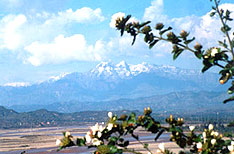 Amongst the three regions of J&K, Jammu, perhaps, offers the widest diversity of terrain and beauty. It is perched on the first sloping ridge rising from the plains of Punjab. The meandering Tawi River flows in the foothills and the backdrop is the imposing Trikuta range. The entire region is pocketed with lakes and valleys of which some are still little explored. Jammu is actually two towns. The old town sits on a hilltop overlooking the river and several kilometers away across the river is the new town of Jammu Tawi. The foundation of the settlement of Jammu is attributed to King Jambulochan of 9th century BC. In 1730 it came under the Dogra rule of Raja Dhruv Deva and became an important centre for arts and culture. Religion, too, played an important part in its development, so beautifully evidenced in its various shrines and temples spread throughout the region. Jammu is essentially a town of temples and shrines.
Amongst the three regions of J&K, Jammu, perhaps, offers the widest diversity of terrain and beauty. It is perched on the first sloping ridge rising from the plains of Punjab. The meandering Tawi River flows in the foothills and the backdrop is the imposing Trikuta range. The entire region is pocketed with lakes and valleys of which some are still little explored. Jammu is actually two towns. The old town sits on a hilltop overlooking the river and several kilometers away across the river is the new town of Jammu Tawi. The foundation of the settlement of Jammu is attributed to King Jambulochan of 9th century BC. In 1730 it came under the Dogra rule of Raja Dhruv Deva and became an important centre for arts and culture. Religion, too, played an important part in its development, so beautifully evidenced in its various shrines and temples spread throughout the region. Jammu is essentially a town of temples and shrines.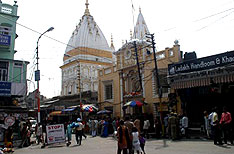 Located in the heart of the city is the largest temple complex in northern India. Dedicated to Lord Rama, it has a unique structure. The inner walls of temple are covered with gold sheet on three sides. The galleries of the temple are covered with lakhs of 'Saligrams' (sacred stones). The surrounding temples are dedicated to other god and goddess from the epic of Ramayana. Construction of the temple was started in 1835 by Maharaja Gulab Singh and was completed by his son Maharaja Ranbir Singh in 1860.
Located in the heart of the city is the largest temple complex in northern India. Dedicated to Lord Rama, it has a unique structure. The inner walls of temple are covered with gold sheet on three sides. The galleries of the temple are covered with lakhs of 'Saligrams' (sacred stones). The surrounding temples are dedicated to other god and goddess from the epic of Ramayana. Construction of the temple was started in 1835 by Maharaja Gulab Singh and was completed by his son Maharaja Ranbir Singh in 1860.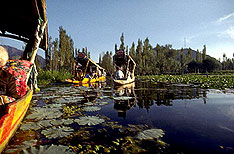 This fresh natural atmosphere combined with the commercial clamor of the old city's twisting medieval streets gives Srinagar a distinctive and vitalizing flavour. Walking down the roads you will see the half- timbered houses and brick churches surrounded by magnolia trees in the garden. The water world of the Dal and Nagin Lakes can be explored in the almost decadent comforts of Shikaras hand paddled water taxis.
This fresh natural atmosphere combined with the commercial clamor of the old city's twisting medieval streets gives Srinagar a distinctive and vitalizing flavour. Walking down the roads you will see the half- timbered houses and brick churches surrounded by magnolia trees in the garden. The water world of the Dal and Nagin Lakes can be explored in the almost decadent comforts of Shikaras hand paddled water taxis.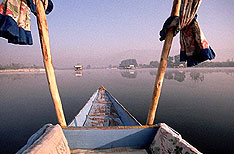 With their famous houseboats and shikaras (canoes) are located in east of the city. Much of the Dal Lake is a maze of intricate waterways. It comprises a series of lakes including the Nagin lake. The lakes have been formed from ancient oxbows created by the Jhelum river as it meandered across the valley floor. The present lakes are only a shrunken shadow of their former selves. The Dal Lake is famous not only for its beauty, but also for its vibrancy, as it sustains within its periphery, a life that is unique anywhere in world.
With their famous houseboats and shikaras (canoes) are located in east of the city. Much of the Dal Lake is a maze of intricate waterways. It comprises a series of lakes including the Nagin lake. The lakes have been formed from ancient oxbows created by the Jhelum river as it meandered across the valley floor. The present lakes are only a shrunken shadow of their former selves. The Dal Lake is famous not only for its beauty, but also for its vibrancy, as it sustains within its periphery, a life that is unique anywhere in world.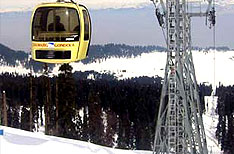 located 52 km southwest of Srinagar is this huge cup shaped meadow, ringed by pine forests, lush and green with slopes where the silence is broken only by the tinkle of cowbells. The name means 'Meadow of Flowers' and in the spring it is just that. All round are the snow-capped mountains, and on a clear day you can see all the way to Nanda Parbat in one direction and Srinagar in another. Gulmarg also has one of the world's highest green 18 hole Golf course which attracts sportsmen in the summer just as its ski runs make it India's premier skiing centre in the winter. Very popular with the tourists is the Gondola Project for a fun filled ride of a most unusual kind. Gulmarg's newly constructed gondola lift (cable car) ferries tourists right up to a height of 3090 m from 2690 m at the base, through pine-clad slopes.
located 52 km southwest of Srinagar is this huge cup shaped meadow, ringed by pine forests, lush and green with slopes where the silence is broken only by the tinkle of cowbells. The name means 'Meadow of Flowers' and in the spring it is just that. All round are the snow-capped mountains, and on a clear day you can see all the way to Nanda Parbat in one direction and Srinagar in another. Gulmarg also has one of the world's highest green 18 hole Golf course which attracts sportsmen in the summer just as its ski runs make it India's premier skiing centre in the winter. Very popular with the tourists is the Gondola Project for a fun filled ride of a most unusual kind. Gulmarg's newly constructed gondola lift (cable car) ferries tourists right up to a height of 3090 m from 2690 m at the base, through pine-clad slopes.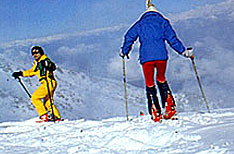 located 84 km northeast of Srinagar is a quiet valley along the Srinagar-Leh Highway. The road that leads to Sonmarg is almost like heading for an enchanted journey into a wonderland of nature. Literally meaning 'Meadow of Gold', has as its backdrop, snowy mountains strewn with the loveliest of alpine flowers and surrounded by towering mountains. The Sindh (Indus) River meanders along here and abounds with trout and mahaseer. Ponies can be hired for the trip up to Thajiwas glacier, a major attraction during the summer months. Waterfalls and the Thajiwas glacier form a sparkling white contrast to the greenery - covered meadows.
located 84 km northeast of Srinagar is a quiet valley along the Srinagar-Leh Highway. The road that leads to Sonmarg is almost like heading for an enchanted journey into a wonderland of nature. Literally meaning 'Meadow of Gold', has as its backdrop, snowy mountains strewn with the loveliest of alpine flowers and surrounded by towering mountains. The Sindh (Indus) River meanders along here and abounds with trout and mahaseer. Ponies can be hired for the trip up to Thajiwas glacier, a major attraction during the summer months. Waterfalls and the Thajiwas glacier form a sparkling white contrast to the greenery - covered meadows.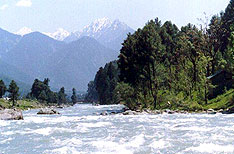 It is located 95km east of Srinagar is Kashmir's premier resort, spread along the banks of the Lidder River. It is the base of several trekking trails such as to the Kolohoi Glacier, Amarnath, Zanskar and Kargil. Around Pahalgam are many places of interest. The most beautiful of these is the huge undulating meadow of Baisaran, surrounded by thickly wooded forests of Pine. Pahalgam has within it no fewer than eight tiny villages one of which is Mamal. There is a Shiva temple here, generally considered to be Kashmir's oldest existing temple dating to the 8th century. The nearby meadow of Chandanwari is the starting point of the Amarnath Yatra (One of the most sacred Hindu pilgrimages) which takes place every year in the month of July-August. The destination Amarnath Cave is the abode of Lord Shiva. During the month of Sawan (Monsoons), an ice stalagmite forms a natural Shiva linga, which waxes and wanes with the phases of the moon.
It is located 95km east of Srinagar is Kashmir's premier resort, spread along the banks of the Lidder River. It is the base of several trekking trails such as to the Kolohoi Glacier, Amarnath, Zanskar and Kargil. Around Pahalgam are many places of interest. The most beautiful of these is the huge undulating meadow of Baisaran, surrounded by thickly wooded forests of Pine. Pahalgam has within it no fewer than eight tiny villages one of which is Mamal. There is a Shiva temple here, generally considered to be Kashmir's oldest existing temple dating to the 8th century. The nearby meadow of Chandanwari is the starting point of the Amarnath Yatra (One of the most sacred Hindu pilgrimages) which takes place every year in the month of July-August. The destination Amarnath Cave is the abode of Lord Shiva. During the month of Sawan (Monsoons), an ice stalagmite forms a natural Shiva linga, which waxes and wanes with the phases of the moon.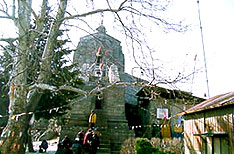 It is located on the Takht-e-Suleman (throne of Solomon) across the combined lakes. The views from here are spectacular. One can see the entire city of Srinagar and the Jhelum valley with the river meandering its way through it.
It is located on the Takht-e-Suleman (throne of Solomon) across the combined lakes. The views from here are spectacular. One can see the entire city of Srinagar and the Jhelum valley with the river meandering its way through it.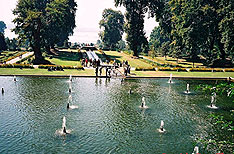 The Mughal Gardens are located on the far east of the Dal Lake. The first two gardens, the Chashma Shahi (Royal Spring)and Pari Mahal are to the right of the famous Boulevard Road that circles the Dal Lake. A crystal spring bubbles out of a stone vase at Chashma Shahi. The two larger gardens, Nishat and Shalimar are located much farther down the Boulevard. This is Kashmir at its royal best with the beauty enhanced by the backdrop of lake and mountain and carefully sited for the best views of both.
The Mughal Gardens are located on the far east of the Dal Lake. The first two gardens, the Chashma Shahi (Royal Spring)and Pari Mahal are to the right of the famous Boulevard Road that circles the Dal Lake. A crystal spring bubbles out of a stone vase at Chashma Shahi. The two larger gardens, Nishat and Shalimar are located much farther down the Boulevard. This is Kashmir at its royal best with the beauty enhanced by the backdrop of lake and mountain and carefully sited for the best views of both.